Samsung Galaxy Note 3 Review
by Brian Klug on October 1, 2013 9:00 AM EST- Posted in
- Smartphones
- Samsung
- Mobile
- Android 4.3
- galaxy note 3
Display
One of my only issues with the Note 2 after using it for a long time was resolution. Although the move to a subpixel matrix with a full 3 subpixels per pixel on the Note 2 honestly really put most of my concerns at bay at launch, 720p started to feel limiting further on in that product’s cycle. Having more display area is great, however in Android what really matters is resolution. It was ironic having this phone with a huge display, but 720p resolution that was quickly eclipsed by devices with so much smaller displays. With the Note 3 Samsung moves to 1080p at 5.7 inches, up from the 720p at 5.5 inches in the Note 2, and 1280x800 at 5.3 inches from the original Note.
A question that immediately comes up every time we get a Samsung phone with AMOLED is first, what kind, and second what subpixel unit cell is behind it all, be it an RGB stripe or some other RG,BG alternative unit cell. In the case of the Note 3 we unsurprisingly see Samsung use the same unit cell as they did on SGS4, an offset pattern with green on one line and red and blue on another line. There’s a square blue subpixel with more area than the circular red and green subpixels as well to compensate for the difference in luminous efficiency of the material used in each subpixel type. As I’ve said in the past this isn’t PenTile (although people have started using that brand as a proxy for RG,BG alternatives) but something else entirely, but the ultimate end is still the same, two subpixels per unit pixel and not an RGB stripe.
The question for most normals then becomes – is this a big deal or can a normal human being see it? I’d argue that the subpixels on the Note 3, like the SGS4, are now small enough that they can’t be seen. I used to very picky about this, but I don’t find the new offset RG,BG pattern distracting at all on the Note 3. Subpixel size moves from just above 1 arcminute (1.006 and 1.073 for the Note and Note 2 respectively) down to 0.741 for the Note 3, making them small enough to in theory exceed human eye resolution of 1 arcminute. I won’t break out the huge table or chart, or go over all of that again, but it’s nice to see that finally be the case with the Note 3.
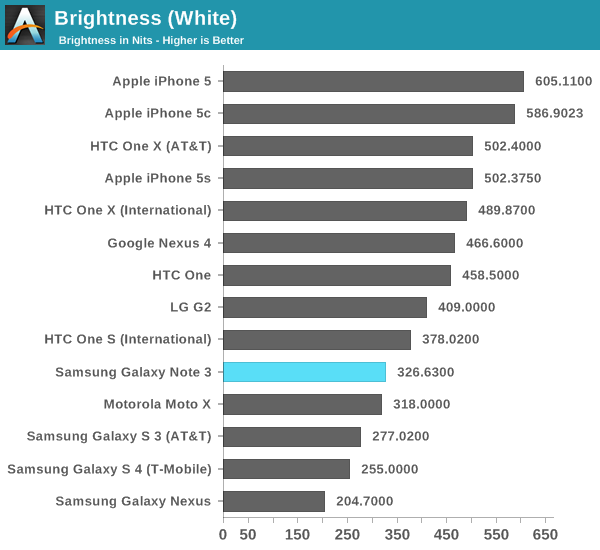
The Note 3 has the same display mode settings as we’ve seen in other generations, these mDNIe toggles allow some control over display color curves. They’re ultimately not a mitigation for Android’s lack of a real CMS and don’t completely solve the oversaturation issue that comes hand in hand with AMOLED’s different spectral curves, but they do help somewhat. These are unchanged as well from the SGS4 – Adapt Display is checked by default and will select which mode to use automatically for first party apps and a few others, but you can select between dynamic, standard, professional photo, and movie manually, which have different tunings for white point, gamut, and saturation. There’s also still the toggle for automatically adjusting screen tone depending on what’s being displayed.
Of the modes and configuration options available, I don’t doubt for a second that the most used one will be the defaults, however if you’re looking for the most sane from a color accuracy perspective it’s still Movie mode with the auto screen tone toggle unchecked. I gave Samsung the benefit of the doubt and ran all my measures in Movie mode as a result, but also took saturation measures of the other modes so you can see the difference in gamut and saturation with what you get under those.

The Standard and Dynamic modes have a ton of oversaturation, extending far beyond sRGB. In Dynamic mode we can also see some compression going on at the higher saturation levels, effectively blowing out those colors even more, with the second to last point almost on top of the last point. Pro Photo mode clamps down gamut and makes saturation a bit more linear, but has some odd other artifacts that show up. With the Movie selection made, the Note 3 display is considerably more controlled and linear, and makes a dramatic difference in how everything appears on the Note 3 during normal use. If you care about display really this is the only setting you should be using.
White point in movie mode is still bluer than I’d like at an average of just over 7100K, but in the all important Gretag Macbeth patch test, Delta-E is pretty low and puts it among iPhone 5, HTC One, and G2 territory. The results under movie mode from the Note 3 are actually nicely controlled. It still isn’t perfect, but there’s at least been an attempt made to give users that option if they don’t want garish colors that might look great on a store display but not so great if you care about matching photos you’ve taken to a display or print later, or web content between desktop and mobile.
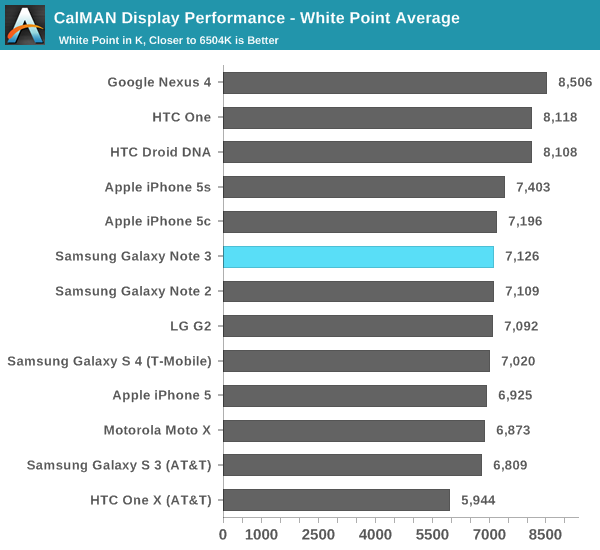
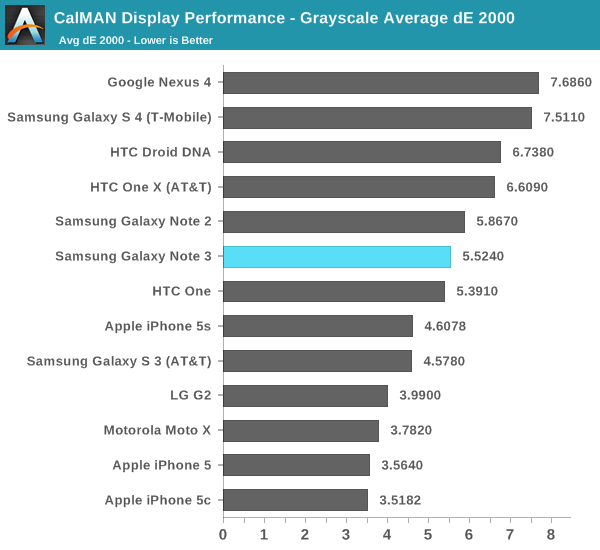
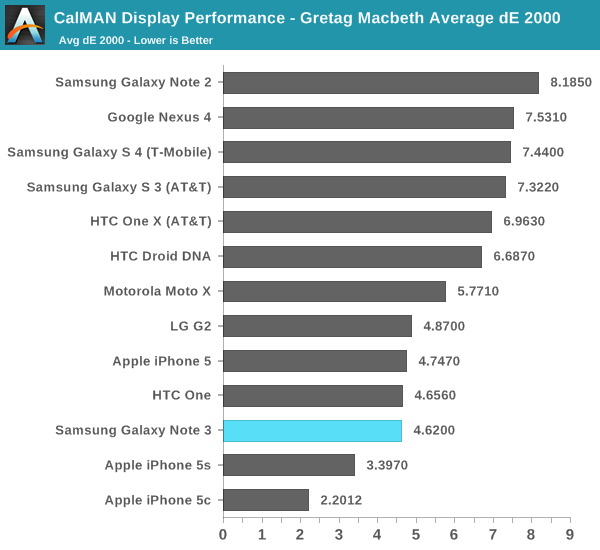
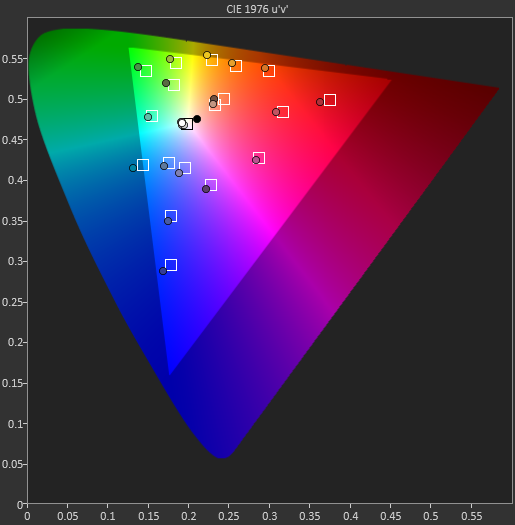
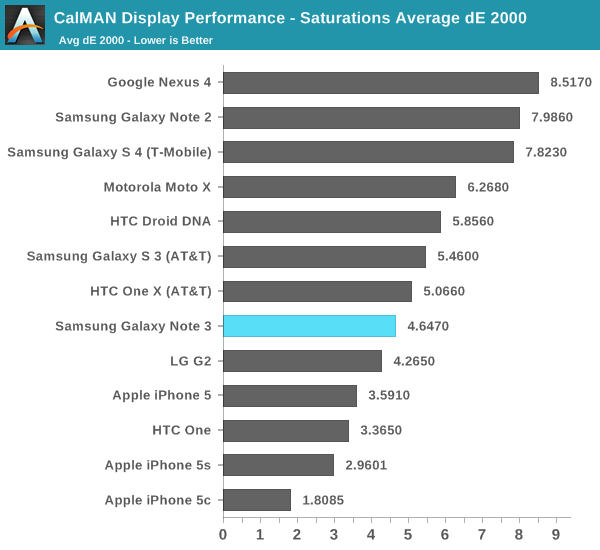



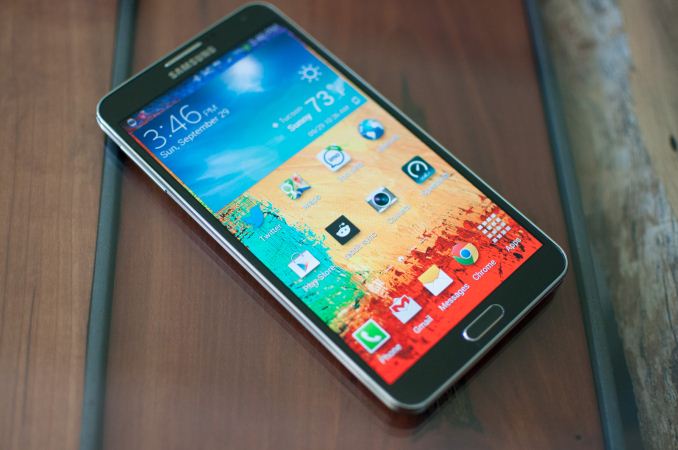
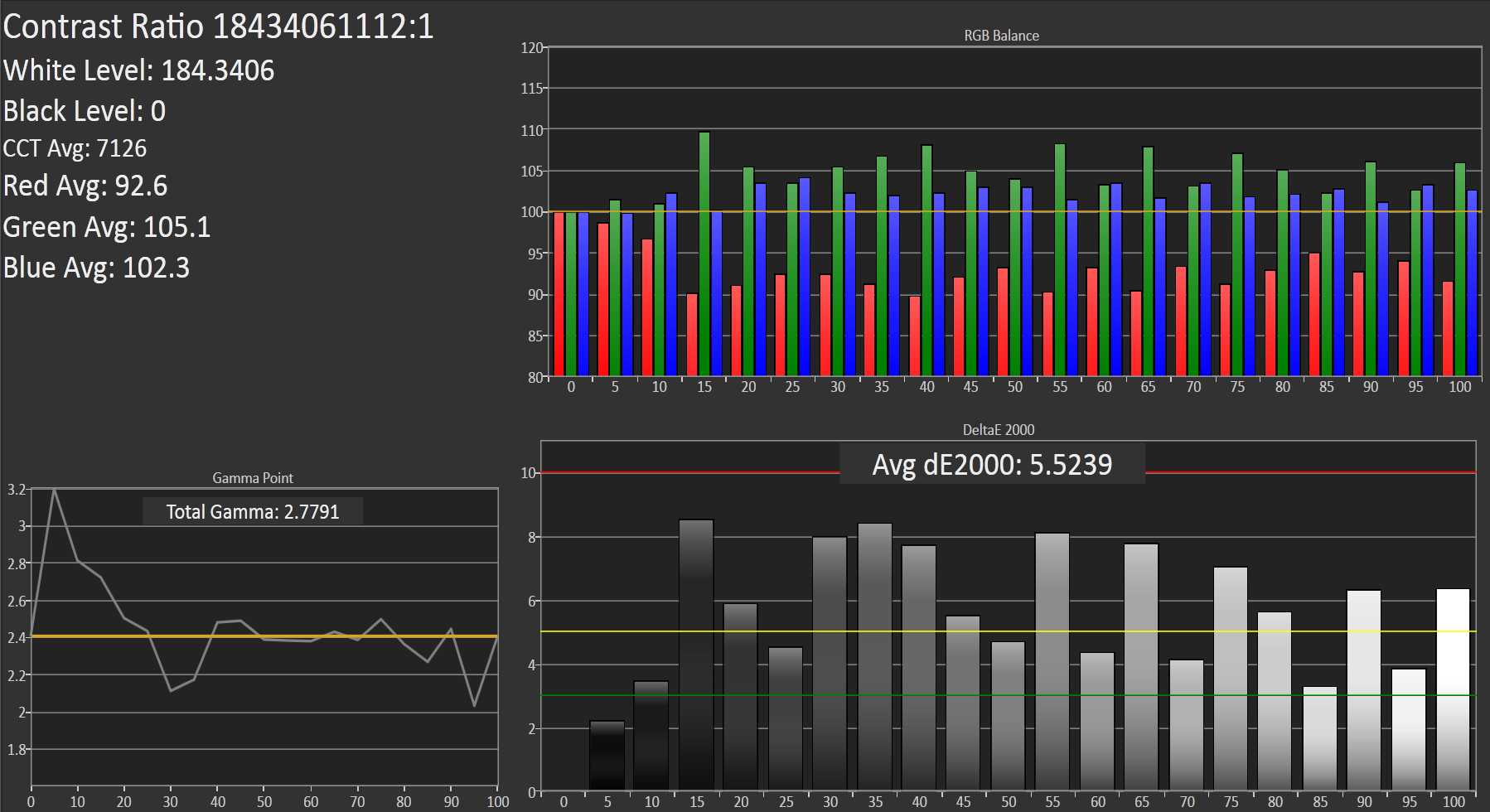








302 Comments
View All Comments
cdomigan - Tuesday, October 1, 2013 - link
Extremely disappointed in AnandTech for their passive stance on benchmark cheating. Please live up to the high expectations you have set for tech journalism and call this out for what it is!Wade_Jensen - Tuesday, October 1, 2013 - link
I would've liked a bit more depth on subjective UX in terms of responsiveness and lag/stuttering. I'm sorry, but I'm starting to think that Touchwiz is just so inefficient and poorly coded that galaxy devices lag no matter how much ram and compute you throw at them.After all S600 was seen as crazy fast at the start of this year but at the end of the day the GS4 still feels slow and heavy for basic operations compared to any other ROM (except motoblur haha).
tanyet - Tuesday, October 1, 2013 - link
I agree with this wholeheartedly. Touch responsiveness and a lag free experience is what I want most in mobile devices. I can say that I haven't noticed any lag or "micro stutters" with my Note 3 and I'm really obsessed with these things. It's still not as smooth as iOS but I feel that's more to do with Android than Samsung. It took me awhile to get used to not having the bounce back effect and it also took awhile to get used to the speed of scrolling (or the abruptness of the scroll stopping) I chalk this up to patent issues. Mine definitely doesn't display the choppiness I've seen with some friends S4's. Who know though. It's early days.I would really love the TouchMarks benchmark to be added to the list of reviewer tools because I feel that it is a much better gauge of user experience than some others.
Dentons - Tuesday, October 1, 2013 - link
Come on Brian. We know you don't care about two of Samsung phone's biggest selling points, user replaceable batteries and MicroSd expansion, but not giving those real, actual features any appreciation or credit at all? That's a bit much.Unlike Brian, some of us really, really, really care that Samsung allows us to carry extra batteries and store our ever growing media libraries on MIcroSD. We know you don't care. You dismiss those features in nearly every Anandtech Podcast, but should your personal use habits so prominently factor into a review this comprehensive?
Apple doesn't have these features.
Google Nexus doesn't have these features.
HTC don't have these features.
It's a major differentiator. For many of us, it's a big deal, perhaps one of the primary reasons many will buy this phone over its competitors.
ScorpionRaY - Tuesday, October 1, 2013 - link
Agree!nerd1 - Wednesday, October 2, 2013 - link
Totally agree. Nowadays micro SD memories are dirt cheap and apple is still charging $100 for extra 16GB...Davidjan - Thursday, October 3, 2013 - link
Agree with you. Meanwhile we can use this Meenova MicroSD reader to add storage: http://goo.gl/U6IyYSpunjji - Tuesday, October 8, 2013 - link
Entirely agreed. I'd have happily bought a Nexus 4 for a lot less money were it not utterly impossible to store my (modest!) media collection and photos downloaded from my camera on there.Similarly I refuse to pay Apple ~£160 extra just to get slightly less capacity with their flagship phone than I got for my Note 2 by paying £40 for a 64GB MicroSD card. Were it not for this option I would have to submit to the blatant scam that is NAND upgrade pricing.
tuxRoller - Tuesday, October 1, 2013 - link
Whoa, what's going on with the G2 in the 4G tests? It was far and away the best at 3G and I thought the current AT reasoning was that 4G only improved the browsing time over 3G by racing to idle? Is the Qualcomm 4G baseband that bad?ithinkux - Tuesday, October 1, 2013 - link
To me, the benchmarks presented above prove, beyond any doubt, that Apple did the right thing switching to 64-bit architecture.